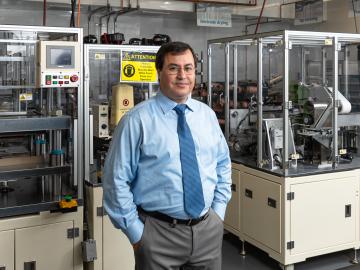
Filter News
Area of Research
- (-) Energy Science (106)
- (-) Materials (62)
- Advanced Manufacturing (5)
- Biological Systems (2)
- Biology and Environment (57)
- Computational Biology (2)
- Computer Science (2)
- Electricity and Smart Grid (2)
- Energy Sciences (1)
- Fusion and Fission (4)
- Fusion Energy (3)
- Isotopes (7)
- Materials for Computing (13)
- National Security (13)
- Neutron Science (28)
- Nuclear Science and Technology (3)
- Quantum information Science (3)
- Sensors and Controls (1)
- Supercomputing (54)
- Transportation Systems (2)
News Type
News Topics
- (-) Bioenergy (13)
- (-) Biomedical (6)
- (-) Energy Storage (44)
- (-) Grid (28)
- (-) Materials Science (43)
- (-) Microscopy (14)
- (-) Polymers (11)
- (-) Summit (3)
- (-) Transportation (46)
- 3-D Printing/Advanced Manufacturing (51)
- Advanced Reactors (4)
- Artificial Intelligence (6)
- Big Data (3)
- Biology (6)
- Biotechnology (2)
- Buildings (24)
- Chemical Sciences (12)
- Clean Water (9)
- Composites (12)
- Computer Science (23)
- Coronavirus (9)
- Critical Materials (8)
- Cybersecurity (6)
- Environment (39)
- Exascale Computing (1)
- Fossil Energy (1)
- Fusion (4)
- High-Performance Computing (4)
- Hydropower (3)
- Isotopes (8)
- Machine Learning (4)
- Materials (46)
- Mathematics (3)
- Mercury (2)
- Microelectronics (1)
- Molten Salt (1)
- Nanotechnology (17)
- National Security (1)
- Neutron Science (15)
- Nuclear Energy (15)
- Partnerships (5)
- Physics (12)
- Quantum Computing (2)
- Quantum Science (2)
- Security (4)
- Simulation (2)
- Space Exploration (5)
- Statistics (1)
Media Contacts

Scientists at Oak Ridge National Laboratory used a focused beam of electrons to stitch platinum-silicon molecules into graphene, marking the first deliberate insertion of artificial molecules into a graphene host matrix.

Ilias Belharouak is leading ORNL’s research efforts in investigating new materials for solid-state batteries, which can double the charging capacity of lithium-ion batteries, commonly used today for electronic devices such as cell phones.

Scientists at the Department of Energy’s Oak Ridge National Laboratory have developed a new method to peer deep into the nanostructure of biomaterials without damaging the sample. This novel technique can confirm structural features in starch, a carbohydrate important in biofuel production.

Each year, approximately 6 billion gallons of fuel are wasted as vehicles wait at stop lights or sit in dense traffic with engines idling, according to US Department of Energy estimates.

Researchers at ORNL demonstrated that sodium-ion batteries can serve as a low-cost, high performance substitute for rechargeable lithium-ion batteries commonly used in robotics, power tools, and grid-scale energy storage.

The formation of lithium dendrites is still a mystery, but materials engineers study the conditions that enable dendrites and how to stop them.

Liam Collins was drawn to study physics to understand “hidden things” and honed his expertise in microscopy so that he could bring them to light.

Scientists at have experimentally demonstrated a novel cryogenic, or low temperature, memory cell circuit design based on coupled arrays of Josephson junctions, a technology that may be faster and more energy efficient than existing memory devices.

Oak Ridge National Laboratory researchers created a geothermal energy storage system that could reduce peak electricity demand up to 37% in homes while helping balance grid operations.

To better determine the potential energy cost savings among connected homes, researchers at Oak Ridge National Laboratory developed a computer simulation to more accurately compare energy use on similar weather days.


